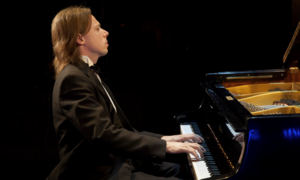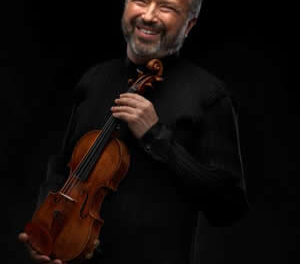When the first Paderewski Festival was held in Raleigh in 2014, its closing recital was played by Peter Toth. CVNC’s Chelsea Huber’s review said that Toth’s “unique artistry was breathtaking from start to finish.” Little has changed in that regard, as the Hungarian pianist (now living in New Jersey, where he teaches at Fairleigh Dickinson University) brought deep insights into his masterful playing of a program ranging in time from Handel to Bartók.
Where yesterday’s opening Festival artist, Avery Gagliano, is in the early part of her career, competing in the unique artistic sport of piano competitions, Toth had retired from competition shortly before his 2014 Raleigh recital. As a performer and teacher, he is now widely respected throughout the musical world. His playing is not flamboyant; he lets his fingers channel his emotions in service to the music, with special attention in this program to his Hungarian compatriots Franz Liszt and Béla Bartók.
He opened his program with Handel’s Chaconne in G, HWV 435. A set of 20 variations over a ground bass and a repeated harmony, this form was a favorite of Handel’s, including its use in more than one of his organ concertos. Playing this music on a modern piano rather than on a harpsichord (for which Handel wrote it) frees the performer from any restrictions respecting “historical performance,” providing the pianist with a greater dynamic range and wider possibilities of tempo variations. Toth succeeded in making Handel’s music sound natural on the Steinway piano, often letting the tempo increase as the number of right-hand notes increased.
Mozart’s rather moody Adagio in B minor, K. 540 followed. Toth brought out the intense conversations between the inner voices in his evocative performance. Schubert’s Impromptu in C minor, D. 899, was fiery, even percussive at times, becoming a foretaste of the program’s next work, Bartók’s Suite, Op. 14. In this four-movement 1916 work, Bartók intentionally left behind his post-Romantic writing, using varied tonal scales (including a 12-tone scale in one movement) and a much leaner and generally more percussive approach to the piano. Toth’s performance was fabulous, from the white-heat moments through the work’s gently-quiet close. One is not likely to hear this work, first performed by the composer himself in 1919, played more convincingly.
Following intermission, Toth brought back the Paderewski work which he played in 2014, the B-flat Nocturne, Op. 16, No. 4. Here we heard the pianist’s command of touch, as his right hand spun out melodic lines in tenor and soprano voices against a gentle, caressing left-hand ostinato figure. Paderewski would have approved.
The program concluded with both little-known and very familiar works of Liszt. First came four excerpts from the Hungarian Historical Portraits, the composer’s musical artwork depicting Hungarian statesmen, poets, and musicians. Each musical “portrait” is as unique as a canvas portrait would have been. Perhaps the most interesting was the first, “László Teleki,” where the ostinato bass line, sometimes thundering, sometimes quiet, sometimes accented by a tremelando, awakened bell-like harmonics from deep within the piano. Toth drew color after color from the piano in his impassioned performance, a tour-de-force of command.
The program’s final work was also on Toth’s 2014 Festival recital: Liszt’s sixth Hungarian Rhapsody, S. 244. This is the Liszt of technical wizardry, of Sturm und Drang, of audience-delighting and of virtuosity. Toth gave it an electrifying reading, bringing the audience to its feet and continuing to applaud until they received a welcome encore: Liszt’s “Csárdás Obstiné,” its driving rhythms leading its harmonies from minor to major and back again. The final right-hand octaves take over the dance in a flurry of twirling skirts in Liszt’s bravura music, matched by Toth’s bravura performance.
The Paderewski Festival concludes with dual recitals by pianist Eric Guo at the NC Museum of Art on November 13 and 14, at 3:00 PM. See our calendar for more details.












